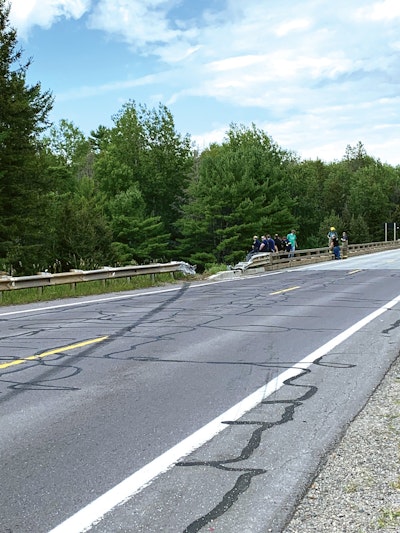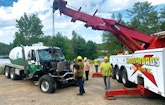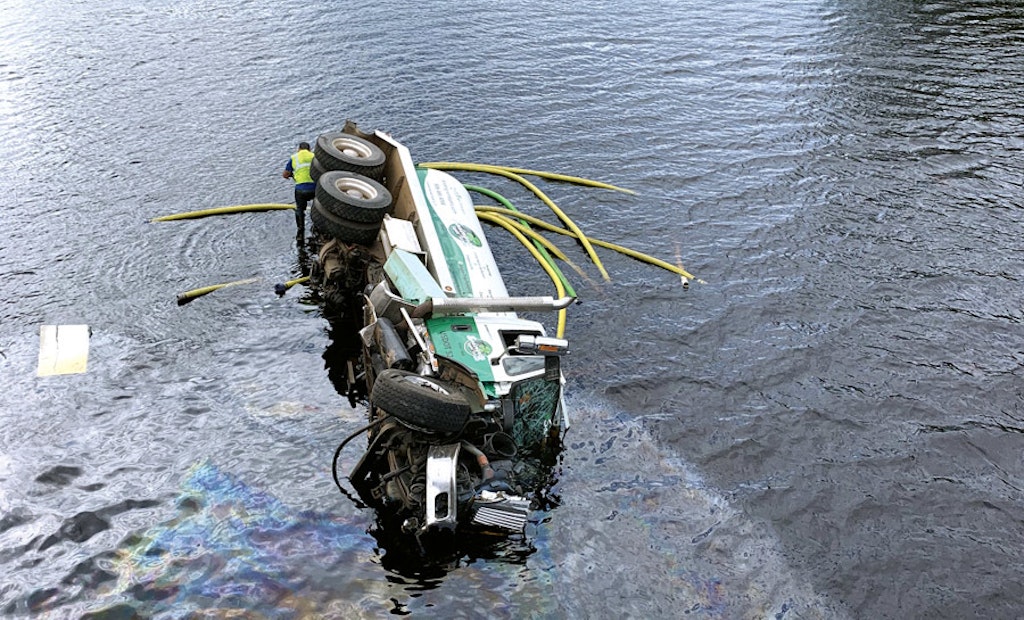Ryan Carey was on the way to another appointment when his cellphone rang. It was one of his drivers, who sounded frantic. The driver had just passed over a bridge in Michigan’s Upper Peninsula and was shocked by what he observed.
“There’s a septic truck in the river and I think it’s one of our trucks,” the driver reported. Carey, heading the other direction about 20 minutes away, turned the truck around and pinned the accelerator to get to the bridge over the Michigammie River as quickly as possible.
“You can imagine all the things that were going through my mind,” Carey says as he recalled the events of that late summer afternoon. As the president of Sodergren Septic Service/J.Carey Inc., in Negaunee, Michigan, rolled up to the scene, “the state police were there, the ambulance was there, but I didn’t see the truck at first.”
Longtime driver Dave Farkas’ rig was laying driver’s side down in the middle of the river, a 30-foot drop and about 100 feet out from the twisted, broken guardrail. The front end of the 2002 International was a mangled mess and the suction hoses were being carried away by the current. A petroleum sheen was radiating away from the truck.
“Where’s Dave?” Carey remembers asking a state trooper on the scene. He was in the ambulance getting checked over. “Thank God he was OK.” Farkas would go on to the local hospital to get checked out, but he suffered no serious injuries, and while Carey was thankful and relieved his driver was OK, his work at the site was just beginning.
Carey learned a lot about the need for emergency preparedness that day. The incident also encouraged him to refocus his priorities to help his crew take their time on the job and not pressure themselves to do too much during the workday. And it reminded him of the importance of ongoing driver safety training.
“It could happen in the blink of any eye; I just want to be ready for that,” says Carey, whose company is coincidentally profiled in this issue of Pumper.
SO WHAT HAPPENED?
When you hear the circumstances of this crash, it’s amazing that Farkas and everyone else involved walked away unscathed.
Farkas was between pumping runs, driving his International carrying about 1,000 gallons of septage in the 3,200-gallon tank traveling northbound over the Old M-95-Michigammie River Bridge at Republic, a small town west of Marquette, Michigan. From the south, Carey recounts, Farkas’ truck was approached by a truck towing a pontoon boat over the bridge. Suddenly, two older women in a small sedan pulled out from behind the truck and boat to pass.
Farkas had no time to react, and swerved the truck toward the side of the bridge deck to avoid the car. The car turned back into its lane, struck the boat and then spun around and hit the septic truck. Carey suspects the pumper’s steer tire was blown by the collision, after which the truck crossed the bridge, knocked out a concrete abutment and guardrail, and was hurtled into the river.
“If he wouldn’t have swerved; he basically saved their lives,” Carey says of the women in the sedan that would have been no match for the loaded truck. “The unbelievable thing about it is that nobody was hurt.”
According to Carey, Farkas apparently passed out momentarily, and when he came to, he was under water. “The worst part was getting out of the truck, getting his seatbelt off, climbing through the passenger window and on top of the truck,” Carey says. A boater on the river heard the crash, sped to the scene and took Farkas to the shore for treatment.
A QUICK CLEANUP
Assured that his driver was OK, Carey turned his attention to the truck in the water. A tow truck and a representative of EGLE (The Michigan Department of Environment, Great Lakes, formerly the state Department of Environmental Quality) were on hand and waiting for Carey to make some decisions about the damaged rig in the water. Carey talked it over and sprang into action.
“The biggest thing was making sure the truck got out of the water along with any debris. I basically went swimming and drug the debris out of the river,” Carey says. The water was 5-feet deep at the deepest point around the truck, and Carey snared the hoses, the truck’s hood, a toolbox, some septic supplies carried onboard and random bits of metal and fiberglass.
Though the truck was a total loss, the steel waste tank was undamaged and none of the septage was spilled. The only hazardous material was a few jugs of engine oil kept in a toolbox, which leaked and caused the sheen in the water. Oil socks were borrowed to clean up the spill and the tow truck moved the damaged rig and pulled out the concrete chunk. The accident happened shortly after 2 p.m., Carey arrived close to 3 p.m. and the cleanup was finished by 10 p.m.
“He was happy we got everything taken care of that evening,” Carey says of the environmental official. If the crash wasn’t the septic company’s fault, why did Carey have to take care of the cleanup?
“Michigan is a no-fault state, so all parties involved and their insurance companies would end up footing the bill,” he says. “In EGLE’s eyes, it was our truck in the river and they were looking for us to take care of it, and the sooner the better. And that’s just our general attitude about everything, just get it done.”
BACK ON THE ROAD
Regular septic route driver Farkas took about a week off to recover from the crash, and when he returned, Carey surprisingly already had a bigger and better new truck waiting for him. The day after the crash, a Friday, Carey called his representative at Imperial Industries to find out what they had in stock and ready to go. He ordered a 2021 International HV Series truck carrying a 4,000-gallon aluminum tank and National Vacuum Equipment 4310 blower. The truck arrived the following Wednesday and a local graphics company got it lettered right away.
“He absolutely loves the truck,” Carey says of Farkas. Especially the automatic transmission, the first truck Carey has ordered that doesn’t require jamming gears. “The auto transmission is unbelievable. I can’t imagine not having an automatic transmission in that application ever again. It’s just unreal getting into some of the residential areas we go into.”
Carey also appreciates the automatic after learning through experience that CDL drivers today don’t necessarily know how to handle a manual. He says the automatic makes the driver’s day go smoother, saving them time shifting a couple thousand times. That’s time they can spend on customer education, much more important in Carey’s eyes.
What about the old truck? Carey expects to buy it back from the insurance company and put the older Imperial tank onto a new truck body and get it back on the road to serve the growing company.
LESSONS LEARNED
The crash revealed a few areas of concern for Carey. The first is that his company doesn’t have an emergency response plan in place. He was fortunate to be on the scene and able to immediately fulfill all the demands of the environmental department. What if he was gone on vacation or unable to respond, Carey wondered?
“We have enough trucks on the road on any given day. I want to get certified in environmental cleanup or at least have a protocol emergency management plan in place so that if this happens, everyone knows what we have to do,” Carey says. He would like to get his team trained to do remediation rather than hiring out for those expensive services. He felt especially lucky this time because the waste tank wasn’t compromised, which could have led to bigger problems.
He plans on working with EGLE and his insurance carrier to develop emergency response training and will also bring this up with the Michigan Septic Tank Association. Carey is an active member in the group and believes other pumpers in the state could benefit from this unfortunate experience.
Another area of concern is distracted driving in a day when drivers carry cellphones and assignments come into the truck through a GPS app. While Farkas was not distracted and his quick actions may have saved lives in this case, Carey realizes distracted driving could be a big problem for small businesses that have service trucks on the road. It’s an ongoing topic of discussion, but Carey sees the value of formal driver training.
TAKE IT EASIER
Lastly, Carey wants to stress that his crew should take their time and not worry so much about squeezing in that extra tank at the end of the day. Their safety is too important to rush the job.
“It’s so easy to get wrapped up in what we do. If you’re getting behind in appointments, as a rule don’t be rushed all the time and enjoy it. Take your time. As far as customer service goes, in a perfect world it would be nice to take more time with the customers. Slow down a little bit. You don’t have to do 20 things a day. Do a good job and be thorough.”
I know it’s hard to slow down when the days are long, the jobs are piling up and then the inevitable emergency call comes in. But Carey learned that some things are more important than trying to do everything. And that your life can change on a dime when you least expect it.
At the end of that stressful day, Carey reflected on the events via his company’s Facebook page.
“Accidents like this remind you how lucky we all are to live where we do with the friends and family we have,” he wrote. “I’ve never been so happy to see Dave sitting up in that ambulance with only a few scratches.”










